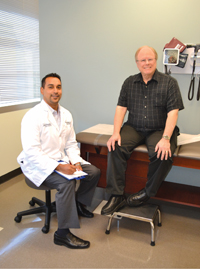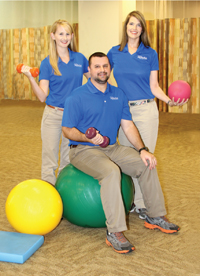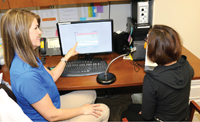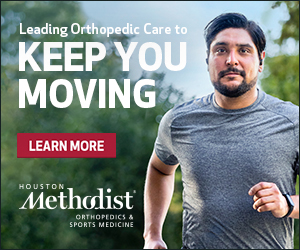Posted on Oct 31, 2015 in
FEATURES

Dr. Toby Yaltho and David Funderberg.
Parkinson’s disease affects more than one million Americans. It is the second most common neurodegenerative disease after Alzheimer’s disease.
Although Parkinson’s disease produces familiar symptoms, its diagnosis may be delayed because symptoms often develop slowly over many years. Missouri City resident David Funderberg’s Parkinson’s disease is managed by specialists at Houston Methodist Sugar Land Hospital’s Neuroscience & Spine Center. Funderberg believes the ground-breaking treatment and therapy he has received, right in his own backyard, have made a huge difference in how he meets the challenges of Parkinson’s disease.
Diagnosing Parkinson’s Disease
When Funderberg began to show mild symptoms of the disease, he wasn’t certain what was going on. “I noticed that my left arm and leg were stiff,” Funderberg recalled. “I could tell, but others couldn’t.” Within two years, the symptoms of difficulty with walking and balance became more prevalent, and his wife urged him to consult with his doctor.
Once a neurologist diagnosed Parkinson’s disease, Funderberg started medication to help control his symptoms. “I had two out of the three main symptoms pretty profoundly. But despite the medication I began taking, the disease continued to progress. My symptoms became worse.”

Therapists Kimberly Kainer, MOT, OTR; Dan Kershner, PT and Kathleen Thoede, MA, CCC-SLP. Photo by Mary Favre.
Symptoms of Parkinson’s disease vary from person to person and can include a tremor, or shaking, often in a hand, arm or leg, stiff muscles, slow movement and difficulty with walking and balance. At that time, there were no definitive lab tests to diagnosis Parkinson’s, making it difficult to diagnose. Recently, Houston Methodist Sugar Land Hospital acquired the first imaging agent approved by the FDA for use in capturing images of the brain to accurately diagnose patients with parkinsonian syndrome.
“The challenge for physicians is differentiating parkinsonian symptoms from other conditions, such as essential tremor, that can be similar,” said Toby Yaltho, M.D., fellowship-trained movement disorders neurologist with Houston Methodist Sugar Land Hospital’s Neuroscience & Spine Center.
Although Funderberg had been diagnosed and was taking medication, he wasn’t in a program that actively assisted him with managing his symptoms. Funderberg’s wife felt there had to be more than just living with Parkinson’s disease, and that’s when she found Yaltho.
“My wife read an article in a magazine about Dr. Yaltho and really liked what he had to say,” said Funderberg, who has been a patient of Dr. Yaltho for the past year. “Dr. Yaltho has been a real blessing to us. He introduced me to some ideas that no one had ever offered me, including BIG® and LOUD®.”
BIG® and LOUD® for Parkinson’s Patients
Yaltho believed the hospital’s BIG® and LOUD® program for patients with Parkinson’s disease would help Funderberg. BIG and LOUD was developed by an Arizona-based organization that specializes in helping patients with Parkinson’s disease and other movement disorders through the development of unique technology-assisted therapies. Houston Methodist Sugar Land Hospital’s physical, occupational and speech therapists, Dan Kershner, PT; Kimberly Kainer, MOT, OTR and Kathleen Thoede, MA, CCC-SLP have been specially trained and certified by LSVT Global to provide direct instruction to patients. The therapists at Houston Methodist Sugar Land are the only certified BIG and Loud therapists in Fort Bend County.
Funderberg participated in the program for three months. “I didn’t know what to expect,” said Funderberg. “The therapists were extremely knowledgeable and helpful. Today, I still use many of the techniques they taught me, such as how to walk when my medications aren’t working just right or how to get up from a chair. They teach such practical things, and what they teach becomes part of your memory and routine to help through the tough times.”
Physical Therapist Dan Kershner helped start the Neuroscience & Spine Center’s BIG and LOUD program, and according to Kershner, the patients are seeing real change in their functional abilities.
Kershner worked with Funderberg and has seen first-hand the difference the BIG and LOUD program can make. “Mr. Funderberg had some difficulty with freezing of gait, a symptom of Parkinson’s disease when movement stops,” explained Kershner. “To assist with this symptom, we look for cues – called a ‘go signal’ – to trigger movement again. This tells the body that it’s time to move, and movement flows almost reflexively.”
In the beginning phases of therapy, therapists give patients a verbal or contact “go signal,” and as therapy progresses, therapists work with patients to cue themselves internally. “Mr. Funderberg responded very well to this technique and was quickly able to use his ‘go signal’ to help him get out of bed with less effort and to walk through doorways and thresholds without shuffling steps and freezing.”
“I enjoyed working with Dan. He was very helpful and very calm. I really appreciated him,” said Funderberg of his time with Kershner.
Another component of the BIG and LOUD program is speech therapy. “Patients with Parkinson’s disease often find that their voices are impacted as well as their bodies,” said Yaltho. “They stutter or have difficulty with articulation, which makes it difficult to be understood – primarily because the disease is affecting the muscles that control breathing and speech. As a result, they become increasingly reluctant to speak up, especially in public settings. It directly impacts their ability to communicate with others, even family members.”
Funderburg worked with speech therapist Kathleen Thoede, MC, CCC-SLP, in Houston Methodist Sugar Land Hospital’s BIG and LOUD program. “I have a musical background, and many times, the exercises Kathleen gave me reminded me of vocal exercises. We had a great time, and the therapy was very helpful.”
Vast Range of Treatments

Therapist Kathleen Thoede, MC, CCC-SLP works with a patient using the BIG and LOUD therapy program.
While the BIG and LOUD therapy program is an important part of the Neuroscience & Spine Center at Houston Methodist Sugar Land Hospital, it’s one of many treatments provided at the state-of-the-art treatment center. The Center provides diagnosis and treatment for the widest possible range of neurological issues, including Alzheimer’s and memory disorders, amyotrophic lateral sclerosis (ALS), back and neck pain, brain and spinal tumors, epilepsy and seizures, migraines and headaches, multiple sclerosis (MS), peripheral neuropathy, muscle and nerve injuries, and stroke.
In addition to the breadth of services, easy accessibility to neurological care is essential to most patients. As Funderberg noted, “When Dr. Yaltho told me about the BIG and LOUD program, it was initially across town, which wasn’t feasible for me. When they started the program in Sugar Land, I told him immediately to sign me up!”
Funderberg, who turns 63 this month, is excited about his future after finishing his BIG and LOUD therapy. “I would absolutely recommend this program. It’s not easy; I definitely got a workout when I went. But the end result is worth it.”
Funderberg continues to see Yaltho and says that he and his wife are very grateful to him for being progressive. “I feel like Dr. Yaltho was thinking outside of the box for me. He has so many ideas – not just a general approach to Parkinson’s. Dr. Yaltho is giving me real solutions, and I am seeing real results.”
For more information about Houston Methodist Sugar Land Hospital’s BIG and LOUD therapy program or to schedule an appointment, call Maureen Lall, Neuroscience & Spine Center nurse navigator at 281-205-4662.
New Imaging Agent Aids in Parkinsonism Diagnoses
 Diagnosing Parkinson’s disease is a difficult process. Until very recently, the lack of a definitive lab test to diagnose Parkinson’s meant that the disease was primarily diagnosed on the basis of the physical examination. However, with the acquisition by Houston Methodist Sugar Land Hospital of the first imaging technology approved by the FDA to diagnose Parkinson’s, the diagnosis has become much more definitive.
Diagnosing Parkinson’s disease is a difficult process. Until very recently, the lack of a definitive lab test to diagnose Parkinson’s meant that the disease was primarily diagnosed on the basis of the physical examination. However, with the acquisition by Houston Methodist Sugar Land Hospital of the first imaging technology approved by the FDA to diagnose Parkinson’s, the diagnosis has become much more definitive.
DaTscan™ is a radioactive agent that is injected into the bloodstream and flows to the brain, where it can be easily seen with special imaging technology called a SPECT camera. SPECT imaging with DaTscan can help physicians determine if a patient’s movement difficulties are due to a parkinsonian syndrome or another condition known as essential tremor.
“DaTscan is a step in the right direction to help with timely and accurate diagnosis of patients with parkinsonian syndromes, including Parkinson’s disease,” said Toby Yaltho, M.D., fellowship-trained movement disorders neurologist at Houston Methodist Sugar Land Hospital. “These detailed images of the brain, along with physical examinations and clinical history, help us make an accurate diagnosis, and it is wonderful that we have it available here at Houston Methodist Sugar Land Hospital. It will help many patients in Fort Bend and surrounding counties.
For more information or to schedule an appointment, call Maureen Lall, Neuroscience & Spine Center nurse navigator at 281-205-4662.

















 Diagnosing Parkinson’s disease is a difficult process.
Diagnosing Parkinson’s disease is a difficult process.